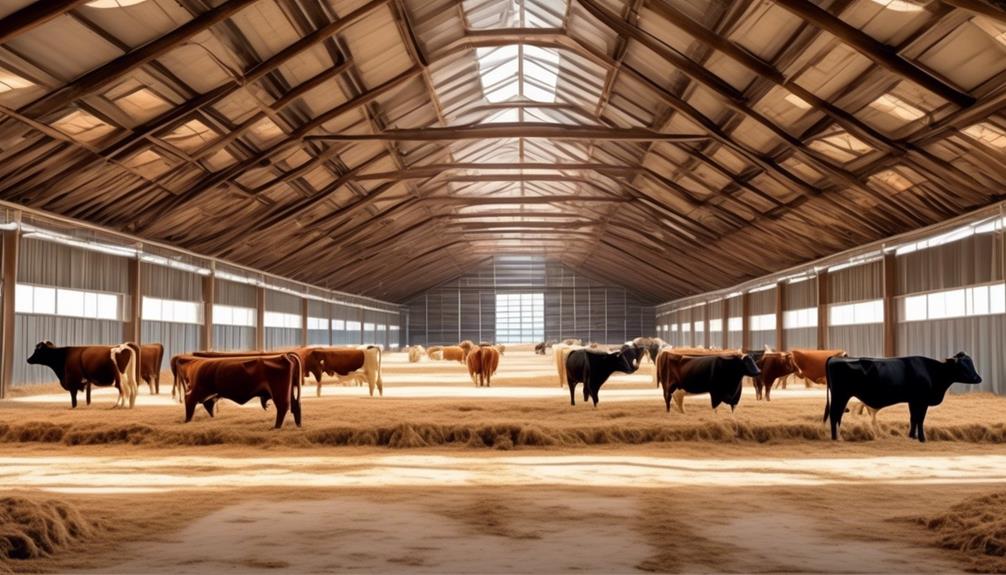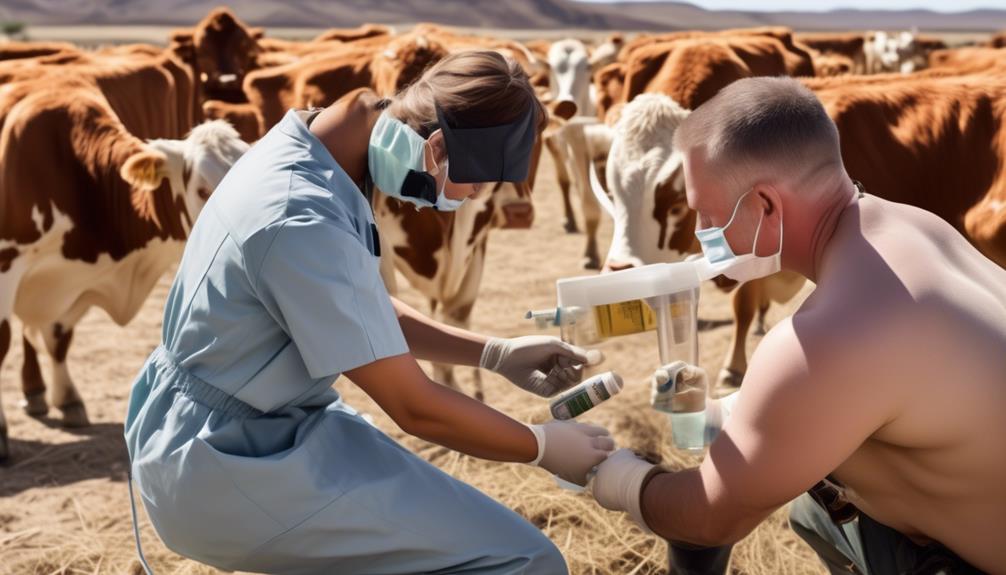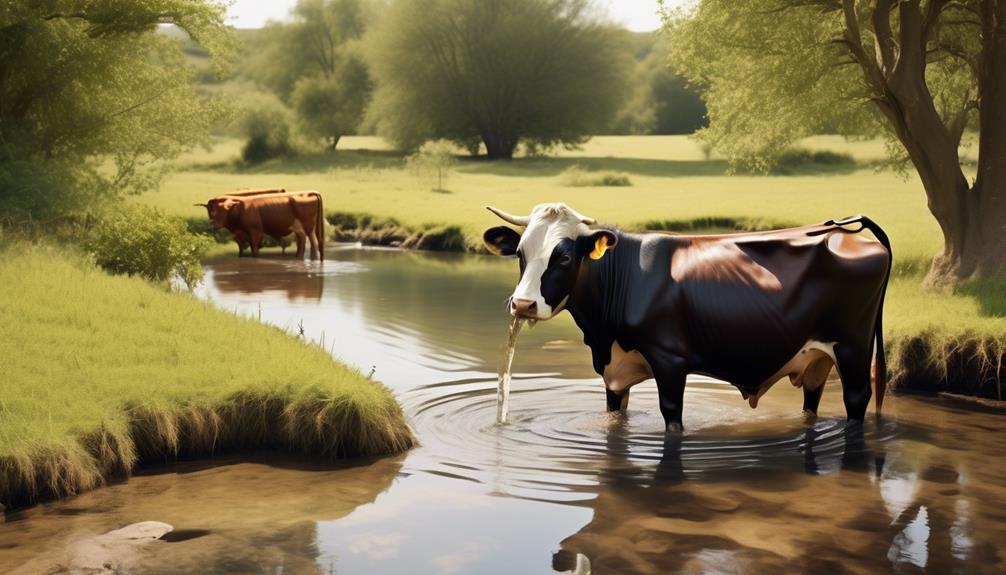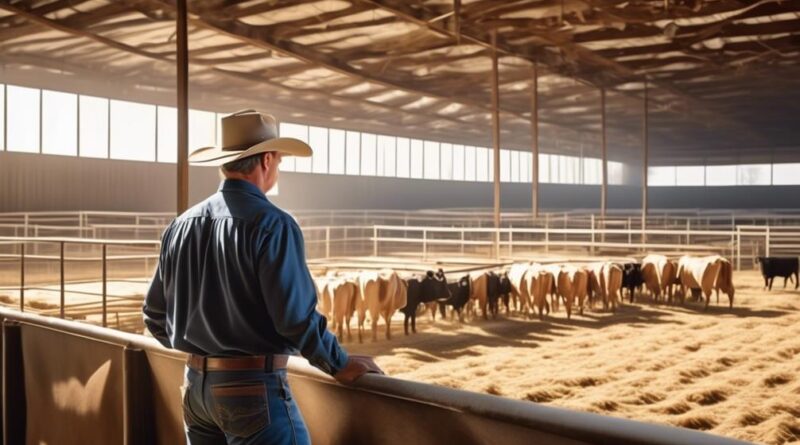7 Tips for Preventing Respiratory Diseases in Cattle
You might not realize it, but respiratory diseases in cattle can have a significant impact on your herd's health and productivity. With the right strategies, however, you can minimize the risk and keep your cattle in top condition.
By implementing a few simple practices, you can safeguard your animals against common respiratory ailments. These tips not only promote the well-being of your herd but also contribute to the overall success of your operation.
Proper Ventilation

To prevent respiratory diseases in cattle, ensure proper ventilation in their housing to maintain good air quality and reduce the risk of infections. Good air quality is essential for the health of your cattle. Ventilation systems play a crucial role in achieving this.
Proper ventilation helps to remove excess moisture, harmful gases, and airborne pathogens from the air, creating a healthier environment for your cattle. Effective ventilation systems ensure that fresh air is constantly brought into the cattle housing while stale air, which may contain contaminants, is expelled. This circulation helps to maintain optimal air quality, reducing the likelihood of respiratory issues among the herd.
Without adequate ventilation, the air can become stagnant and filled with ammonia, dust, and other harmful particles, leading to an increased risk of respiratory diseases.
In addition to preventing the buildup of harmful substances, proper ventilation also helps to control the temperature and humidity levels within the cattle housing. This is important for maintaining a comfortable and healthy environment for the animals. High humidity and excessive heat can contribute to the proliferation of bacteria and mold, which can compromise air quality and lead to respiratory problems in cattle.
Minimize Stress
Minimizing stress in your cattle is crucial for preventing respiratory diseases and maintaining their overall health and well-being. Stress management plays a significant role in the susceptibility of cattle to respiratory illnesses. To minimize stress, it's essential to provide adequate behavioral enrichment for your cattle.
Behavioral enrichment refers to the provision of activities and environments that encourage natural behaviors, such as grazing, exploring, and socializing, which can help reduce stress levels in cattle.
One effective method of behavioral enrichment is to ensure that your cattle have access to ample space for movement and social interaction. Overcrowding can lead to increased stress, so providing sufficient space for your cattle to move around freely and interact with each other can help alleviate stress and reduce the risk of respiratory diseases.
Additionally, incorporating environmental enrichments such as scratching posts, hanging ropes, and other play structures can help keep your cattle mentally and physically stimulated, thereby reducing stress levels.
Furthermore, maintaining a consistent and low-stress handling approach when working with your cattle is crucial for stress management. Sudden loud noises, aggressive handling, and unfamiliar experiences can all contribute to heightened stress levels in cattle. By employing calm and gentle handling techniques, you can help minimize stress and create a more relaxed environment for your cattle, ultimately reducing the risk of respiratory diseases.
Vaccination Protocols

Ensure that your cattle receive the appropriate vaccinations according to recommended protocols to protect them from respiratory diseases. Vaccine efficacy is crucial in preventing respiratory illnesses in cattle. When considering vaccination schedules, it's important to follow the guidance of a veterinarian to ensure that your cattle are receiving the right vaccines at the right time. Vaccines vary in their efficacy, and a veterinarian can help determine the best options for your specific herd based on factors such as age, environment, and potential disease exposure.
Developing a vaccination schedule for your herd involves careful consideration of various factors. Some vaccines require booster shots to maintain their efficacy, while others may provide long-lasting protection with a single dose. Understanding the duration of immunity conferred by each vaccine is essential for planning an effective vaccination protocol. Your veterinarian can provide valuable insights into the ideal timing for administering vaccines to ensure optimal protection against respiratory diseases.
Additionally, it's important to stay informed about any updates or changes in vaccination recommendations. Vaccine formulations and protocols may evolve over time based on new research and developments in veterinary medicine. Regular communication with your veterinarian will help ensure that your cattle receive the most effective and up-to-date protection against respiratory diseases.
Quarantine New Additions
When introducing new cattle to your herd, it's crucial to implement a quarantine period to minimize the risk of introducing respiratory diseases. Isolation precautions are essential during this time to prevent the potential spread of infectious agents to the rest of the herd.
The quarantine period allows for the observation and monitoring of the new additions for any signs of respiratory illness, ensuring that they don't pose a threat to the existing herd.
During the quarantine period, it's important to keep the new cattle separate from the rest of the herd to prevent direct or indirect contact. This isolation minimizes the risk of transmitting any potential respiratory pathogens to the existing animals. Additionally, it provides an opportunity to observe the new additions for signs of illness, such as coughing, nasal discharge, or labored breathing.
Introduction monitoring is a critical aspect of the quarantine period. Regular health checks should be conducted to assess the new cattle's respiratory status and overall well-being. Any signs of respiratory disease should be promptly addressed, and appropriate veterinary care should be provided if necessary.
Furthermore, it's advisable to implement biosecurity measures during the quarantine period to prevent the introduction of respiratory pathogens to the farm. This includes using dedicated equipment and clothing when handling the new additions and avoiding sharing equipment between the quarantined animals and the rest of the herd.
Clean Water Sources

To safeguard the overall health of your herd, maintaining clean water sources is essential, especially following the quarantine period for new additions to prevent the introduction of respiratory diseases. Water quality plays a crucial role in the well-being of your cattle. Ensure that water sources are free from contaminants such as manure, dirt, and debris that could compromise the quality of the water. Regularly inspect and clean water troughs or containers to prevent the buildup of algae and bacteria, which can negatively impact hydration management and overall health.
Hydration management is vital for preventing respiratory diseases in cattle. Clean water sources encourage adequate water intake, which is essential for maintaining proper hydration levels and supporting the immune system. Dehydration can increase the risk of respiratory infections, making it crucial to provide clean and accessible water at all times. Monitor water consumption to identify any potential issues and address them promptly. Additionally, consider the temperature of the water during extreme weather conditions, as cattle may reduce their water intake if the water is too cold or too hot.
Nutritional Management
Maintaining a balanced diet for your cattle is crucial for preventing respiratory diseases and promoting overall health. When it comes to nutritional management, focus on feed quality and grazing management to ensure your cattle receive the necessary nutrients to support their respiratory health.
Quality feed plays a significant role in bolstering the immune system of your cattle, making them more resistant to respiratory diseases. Ensure that the feed provided is fresh, free from mold, and meets the specific nutritional requirements of your cattle. Regularly assess the feed quality to prevent any potential respiratory issues stemming from poor nutrition.
In addition to feed quality, effective grazing management is essential for respiratory health. Properly managed grazing allows cattle to have access to fresh, high-quality forage, which contributes to their overall well-being. Adequate access to grazing areas can also reduce stress levels in cattle, further supporting their respiratory health.
Implement rotational grazing practices to prevent overgrazing and ensure that the pasture isn't contaminated with mold or other respiratory irritants.
Monitoring Environmental Conditions
You can enhance respiratory health in your cattle by regularly monitoring environmental conditions for potential respiratory irritants and ensuring proper ventilation in their living spaces. Here are some key aspects to focus on:
- Temperature control: It's essential to maintain an optimal temperature range within the cattle housing. Ensure that the environment is neither too hot nor too cold, as extreme temperatures can stress the animals and compromise their respiratory health. Regularly check and adjust heating, cooling, and insulation systems as needed to keep the temperature within the recommended range.
- Air quality: Monitor the air quality in the cattle barn or housing area. Poor air quality can lead to respiratory issues in cattle. Implement proper ventilation systems to ensure a constant flow of fresh air and the removal of harmful gases, dust, and moisture. Regularly clean and maintain ventilation equipment to prevent the buildup of contaminants.
- Preventing respiratory irritants: Identify and eliminate potential respiratory irritants in the cattle's environment. This includes minimizing dust, managing ammonia levels, and controlling mold and mildew. Use appropriate dust control measures, such as regularly wetting down surfaces and using dust-free bedding materials. Additionally, keep the barn clean and well-maintained to prevent the accumulation of irritants.
Implement Biosecurity Measures
Implementing biosecurity measures is crucial in preventing the spread of infectious diseases and maintaining the overall health of your cattle. Disease prevention should be a top priority, and implementing biosecurity strategies can greatly reduce the risk of respiratory diseases in your herd.
One of the most important biosecurity measures is controlling the movement of people, vehicles, and equipment onto your farm. Visitors and workers should follow strict protocols, such as wearing clean protective clothing and footwear, and using footbaths to prevent the introduction of pathogens. Additionally, it's essential to quarantine new animals to prevent the potential transmission of diseases to the rest of the herd.
Another critical aspect of biosecurity is maintaining a clean and sanitized environment. Regularly disinfecting equipment, feeding troughs, and water sources can help prevent the spread of respiratory pathogens. Furthermore, proper manure management and maintaining clean living conditions can significantly reduce the risk of disease transmission.
Implementing a vaccination program tailored to the specific respiratory diseases prevalent in your region is also a key biosecurity measure. Consult with a veterinarian to develop a vaccination schedule that provides adequate protection for your herd.
Frequently Asked Questions
How Can I Assess the Overall Respiratory Health of My Cattle?
To assess the overall respiratory health of your cattle, observe for signs of labored breathing, nasal discharge, and coughing. Incorporate good cattle management techniques like proper ventilation, minimizing stress, and providing clean water to maintain respiratory health.
What Are Some Common Signs and Symptoms of Respiratory Diseases in Cattle?
You'll notice signs like coughing, nasal discharge, and difficulty breathing as common symptoms of respiratory diseases in cattle. Treatment options include antibiotics and supportive care, while prevention strategies focus on vaccination, minimizing stress, and good ventilation.
Are There Any Specific Supplements or Additives That Can Help Support Respiratory Health in Cattle?
You can support respiratory health in cattle by considering supplement options and evaluating additive effectiveness. It's important to consult with a veterinarian to determine the best approach for your herd's specific needs.
What Should I Do if I Suspect a Respiratory Disease Outbreak in My Cattle Herd?
If you suspect a respiratory disease outbreak in your cattle herd, quarantine affected animals immediately. Seek veterinary consultation for testing and management. Implement strict quarantine procedures to prevent the spread of the disease within your herd.
How Can I Create an Effective Emergency Response Plan for Respiratory Disease Outbreaks in My Cattle?
To create a contingency plan for respiratory disease outbreaks in your cattle, start by identifying potential risks and developing a response protocol. Train employees on early detection and quarantine procedures to effectively manage any outbreaks.
Conclusion
In conclusion, implementing these 7 tips for preventing respiratory diseases in cattle can greatly improve the overall health and well-being of your herd.
By focusing on proper ventilation, minimizing stress, following vaccination protocols, and practicing quarantine for new additions, you can reduce the risk of respiratory diseases and keep your cattle healthy.
Additionally, providing clean water sources, managing nutrition, and monitoring environmental conditions are important factors in preventing respiratory diseases.
Lastly, implementing biosecurity measures is crucial to prevent the introduction and spread of respiratory diseases in your herd.
By incorporating these tips into your cattle management practices, you can ensure that your cattle remain healthy and thriving.
